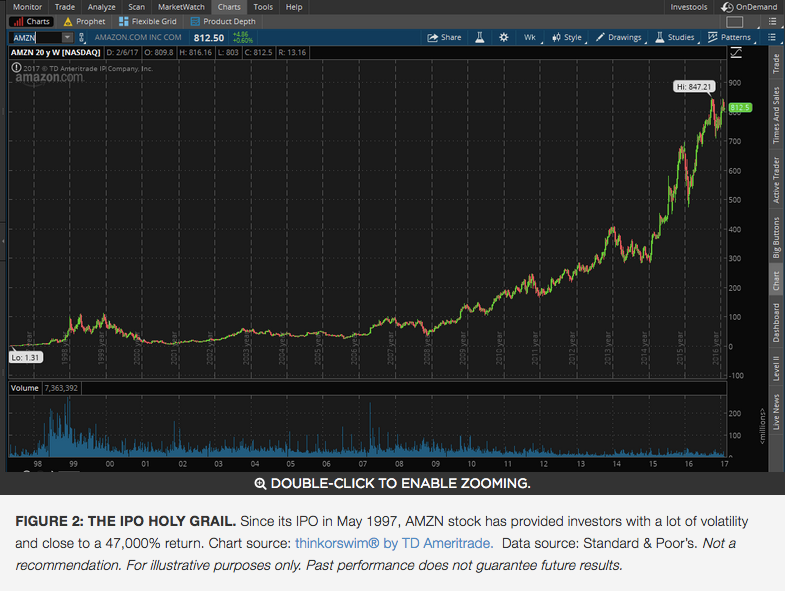IPOs Are Buzzy...But Do They Live Up to The Hype?
Our brains are wired to like new things, even when they aren’t necessarily better than the old. In the world of investing, nothing is newer or can generate more excitement than an initial public offering—commonly referred to as an IPO. There’s a lot of buzz surrounding IPOs and speculation runs rampant as to who will be the next company to file and when.
IPOs that usually create the most buzz are often well-known brands experiencing rapid sales growth in newer industries. Think companies like
Fitbit Inc (NYSE: FIT), GoPro Inc (NASDAQ: GPRO), or Facebook Inc (NASDAQ: FB). Shares for headline generating IPOs can be oversubscribed, meaning demand is much greater than supply for the new shares. This may cause the price to rise when the newly issued stock first begins trading on the exchange. On the other hand, if the supply of shares is much greater than demand, the stock price can rapidly decline.
While you might think you’re buying the next Amazon.com, Inc. (NASDAQ: AMZN) or Microsoft Corporation (NASDAQ: MSFT), there’s also a chance you’re buying the next Fitbit (FIT) or drkoop.com. In case you’re wondering, things didn’t end very well for investors in drkoop.com’s IPO, which reached a valuation of more than $1 billion following its 1999 IPO. Drkoop.com was eventually sold for $186,000 in bankruptcy court in 2002. Fitbit investors fared slightly better, but shares have still declined approximately 70% from its IPO price of $20.00 as the company’s sales growth and profitability declined. Not a total wash but to put that into perspective, take a look at the S&P 500 (SPX) which returned almost 10% during the same time period.
The Next FIT or The Next AMZN?
Investing in IPOs comes with different risks than investing in an established publicly traded company since they are frequently newer companies in younger industries, (and they don’t have the trading history of older, more established publicly traded companies, which helps when conducting research). Once public, the company’s new shareholders may have different ideas how the company should be run, media scrutiny usually increases, there’s greater oversight and regulations from the SEC, and new investors have high expectations for the company’s future growth.
Fitbit, GoPro and Twitter are just some examples of hot IPOs that haven’t lived up to their hype. Many analysts were optimistic about the growth of each company, but the investors who bought these companies when they first became publicly traded have experienced large negative returns and underperformed the S&P 500.
There have been IPOs that generated substantial returns, but it’d take nerves of steel to have bought Amazon, Apple Inc. (NASDAQ: AAPL), or Microsoft Corporation (NASDAQ: MSFT) and not sold your shares. Just check out Amazon’s stock chart in Figure 2 below. Some of the most successful IPOs have also been some of the most volatile. Investors in Apple saw the stock price plunge 71% in 2000 and 57% in 2008 (the S&P 500 only declined 9% in 2000 and 36% in 2008). Microsoft has earned its investors substantial returns since its 1986 IPO, but they had to hold on tight when the stock price declined almost 70% from the beginning of 2000 to the end of 2008.
Caveat Emptor: Buyer Beware
Like any investment, it’s a good idea to research it to make sure it aligns with your financial goals. This isn’t always the case, but newer companies in unproven industries could require more research to fully understand the business and risks.
This is by no means an exhaustive list, but these are some things to consider before investing in an IPO:
Read the SEC Form S-1. This must be filed for a company to register its securities before they can be listed on a public exchange. It provides a detailed look at the business, financial statements, potential risks and how the company plans on using the proceeds from the offering. You’ll also find out important information like what type of shares are going to be available for purchase. More companies are issuing multiple classes of stock that concentrate voting power in the hands of a small number of owners.
Check the lock-up period. Many companies compensate their teams with large stock awards. Lock-up periods usually last 90 to 180 days and prevent employees and other insiders from selling their stock when the company goes public. The stock can be much more volatile depending on lock-up restrictions. These aren’t always set in stone either. Fitbit lifted lock-up restrictions on 2 million shares early and announced an offering of 21 additional shares not long after its IPO. The stock declined 10% in after-hours trading following the news.
Fear of Missing Out? It’s easy to get excited by the buzz surrounding an IPO, but remember you don’t need to buy the stock immediately. If you wait several quarters, you’ll be able to examine additional financial statements to see how the company is growing and management is spending the money it raised.
All investments have different risks that should be considered, and IPOs are no exception. It can be tough, but don’t let the hype influence your research. When your emotions get in the way, it’s easier to ignore all the things that could make that exciting IPO fizzle.
For more information about IPOs check out TD Ameritrade's Investment Products page.
See more from Benzinga
Stocks Appear To Be Headed Toward New Highs Amid Mixed Bag Of Earnings
Earnings: How's Consumer Spending Impacting Macy's, Wal-Mart, And Home Depot Earnings?
Markets Turn Lower As Long Weekend Approaches, But Optimism Seems Evident
© 2017 Benzinga.com. Benzinga does not provide investment advice. All rights reserved.


